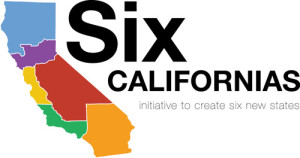By Christina Cameron
In December of 2013, venture capitalist Tim Draper announced his idea to split California into six separate states.
Although talk of splitting up the massive state has surfaced before, Draper may actually have enough support to get his plans on the ballot in November of 2016.
Draper’s ideas would potentially end up on the ballot as an initiative, a process that enables citizens to bypass their state legislature by placing proposed statues and, in some states, constitutional amendments on the ballot, according to the National Conference of State Legislatures. Draper would need a total of 807, 615 signatures to place Initiative #13-0063, or the “Six Californias” Initiative on the ballot in November.
In Draper’s proposal, he states that “California is the nation’s most populous state, nearly six times larger than the average population of the fifty states,” and that “as a consequence of these and other socio-economic factors, political representation of California’s diverse population and economies has rendered the state nearly ungovernable. Additionally, vast parts of our state are poorly served by a representative government dominated by a large number of elected representatives from a small part of our state, both geographically and economically.”
The six proposed states are Jefferson, North California, Central California, Silicon Valley, West California, and South California.
Although the potential capitals are not named in the proposal, The Washington Post predicts that the likely capitals would be Ukiah in Jefferson, Sacramento in North California, Fresno in Central California, San Francisco in Silicon Valley, Los Angeles in West California, and San Diego in South California.
In his proposal, Draper also acknowledges Section 2 of Article III of the California Constitution, which reads, “The boundaries of the State are those stated in the Constitution of 1849, as modified pursuant to statute changing said boundaries or providing legislative authorization to divide the State into two or more states and providing for such transformation.”
Critics of the proposal have been vocal about their concerns. Huffington Post’s Kathleen Miles believes it would be a Dystopian Nightmare, and writes that “It would be Ayn Rand’s dream come true: separate states for rich people and poor people.” Others claim it is a plan to further enhance the gap between the rich and the poor.
Proponents of the proposition say it would solve many of the problems California is facing that are caused by major conflicts of interest because of the vastness of the state. Anna Morris of Six Californias told City News Service that “California has grown ungovernable — be it Arnold Schwarzenegger or Jerry Brown as governor — (and) the problems we face are too ingrained to be fixed in Sacramento.”
In addition to the creation of six new states, Forbes contributor Travis Brown says, “the initiative would 1) proportionately distribute California’s debts based on population, 2) end all tax collections and spending by the existing State of California, and 3) create new, more representative governments that would determine and set changes with respect to taxes, spending, and other public policies for their new state.”
If the initiative is successful, Silicon Valley would be the wealthiest state with an average income of $68,365 and a poverty level of 8.83%. The poorest state would be Jefferson with an average income of $37,277 and a poverty level of 14.14%.
Politically, North California, Silicon Valley, and West California would see the highest numbers of democrats in their states, while Jefferson, Central California, and South California would see more members of the GOP.
On Tuesday, July 15, Draper submitted his gathered signatures to state officials, with hopes of successfully getting his initiative on the November 2016 ballot, according to Reuters.
“Today, we turn in 1.3 million signatures that say we are ready to make a change…We are ready to create six more responsive, representative governments,” Draper said.

